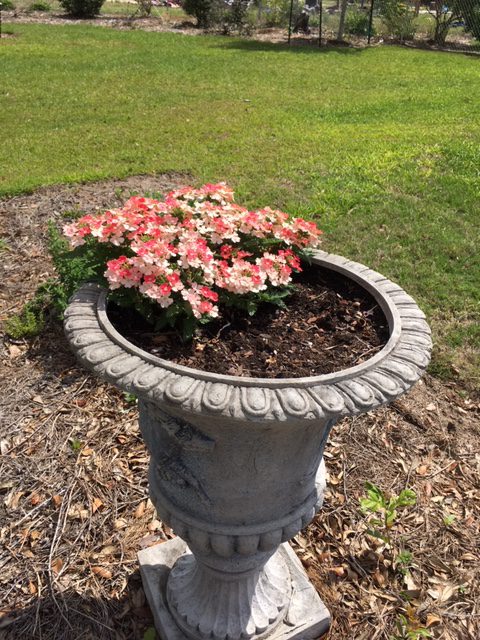
by Julie McConnell | May 17, 2019
Walking around my yard I’m always on the lookout for changes – both good and bad. I look to see which plants are leafing out or flowering. I scout for plant disease symptoms, insect damage, and weeds. I’ve learned over the years that when I spot a plant out-of-place before condemning it as a weed, I need to make sure it isn’t really a bonus plant!
This spring my yard has really changed. After losing numerous mature trees the sun is shining in new spots. Last fall I also had a bit of unexpected seed and vegetation dispersal to say the least, so I’m getting lots of surprises in the landscape. A few bonus plants I’m seeing and leaving alone are oak seedlings, black-eyed Susan, sunflowers, Angelina sedum, dotted horsemint, and verbena.
These plants might not be exactly where I would have placed them, but if they are not located somewhere that will be a maintenance problem, they can stay where they landed. Many of these plants are taking advantage of dry, non-irrigated sites and providing welcome vegetative groundcover that will help prevent erosion. The bonus is that they all provide food or shelter for birds and/or bugs!
How do you tell the difference between a weed and a plant you would like to keep? The key is to pay attention to plant features other than flowers. Start looking at foliage shape, texture, color, growth habit, and how leaves are arranged on the plant. Other characteristics are stem color and shape – some plants have square stems, others have ridges we refer to as “wings” in horticulture terms, tendrils on vines, all of these can be distinctive and recognizable before the obvious flowers form. Keep notes with pictures of plants at different life stages until you commit them to memory. Eventually you’ll be able to walk through your landscape and quickly note the differences which will help conserve those bonus plants and get weeds under control before they get too prolific.
Below are links to sites that might be outside your regular bookmarks. These resources show more than just the pretty flowers and have detailed information on life cycle and growing conditions.
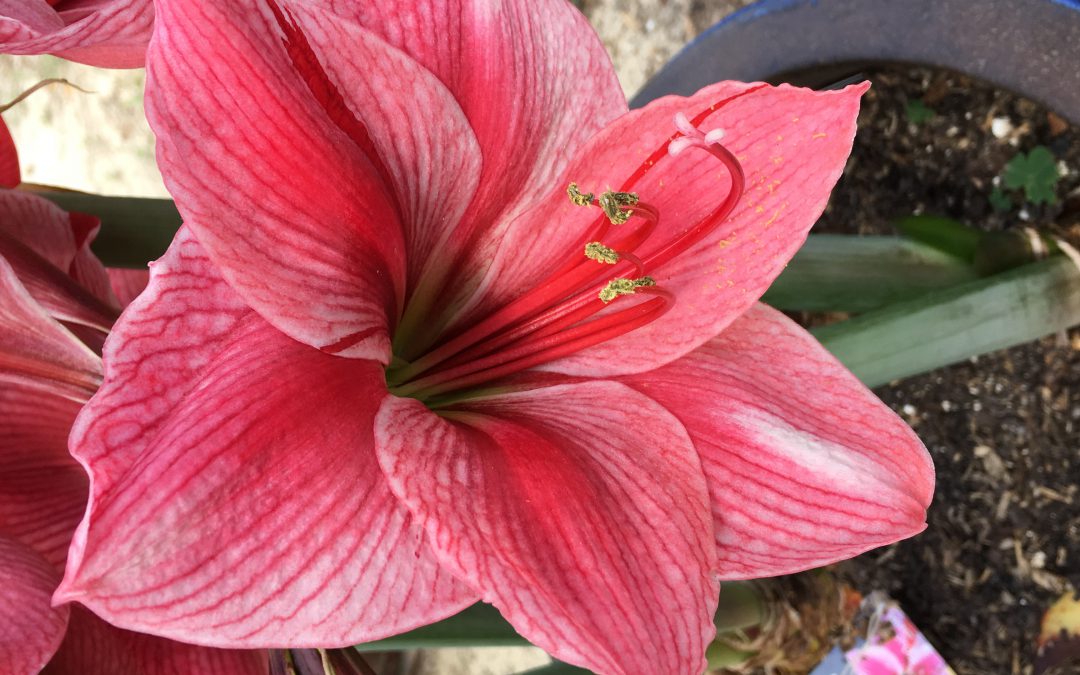
by Logan Boatwright | Apr 16, 2019
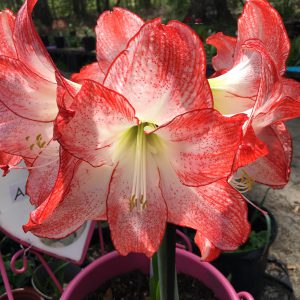
Blooming amaryllis flower. Photo by Logan Boatwright
Are you tired of seeing only green from your shrubs such as boxwood or yew? Are the areas next to your home walls, fences, terraces, tree islands, gate entrances, and/or borders barren? Do you want to add color to these areas? You may want to consider planting these areas with the beautiful amaryllis (Hippeastrum x hybridum).
Amaryllis grows from a tough, dependable bulb that will bloom during the spring after winter dormancy. The strap-shaped leaves will emerge first and grow about 1.5 inches wide, up to three feet long, and persist much of the year in Florida. They are reduced later in the summer and ultimately die back from frost.
In the late winter, bulbs will eventually produce one to three leafless stalks, or scapes, that will each have two or more trumpet-shaped flowers. Flowers come in a variety of forms and shapes: from single and double, miniature or large. Flower colors can be red, bright pink, shades of pink, orange, white, rose, or even salmon. It does not stop there! The flowers may even be striped and multi-colored. Amaryllis can create a striking focal point when they are planted in clusters of 10 or more of similar color.
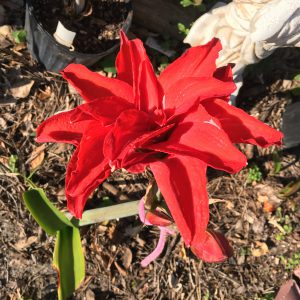
Double flowers of amaryllis. Photo by Logan Boatwright.
Amaryllis may be planted anytime of the year, but winter is best. They are sun- and shade-tolerant, but planting in light shade is best since leaves will yellow in full sun and plants bloom poorly in heavy shade. Amaryllis prefer well-drained sites to prevent bulb and root rots.
For the best amaryllis performance, till and amend the soil with a 3- to 4-inch layer of organic matter and 2 to 3 pounds of 6-6-6, or a comparable amount of other complete fertilizer per 100 square feet. Plant 12 to 15 inches apart. Amaryllis can greatly benefit from at least one fertilizer application in the early spring and two to three applications during the growing season.
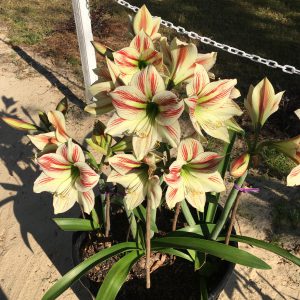
Many blooms from multiple amaryllis bulbs. Photo by Logan Boatwright.
After flowering it’s a good practice to remove the stalks, unless seeds for planting are desired. If the bulbs become crowded, dig and separate them out. Doing this will encourage large, uniform flowers.
Go out, plant a few amaryllis plants today, and be ready to. To learn more about Amaryllis, please follow this link.
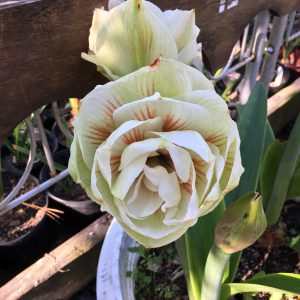
Blooming amaryllis plant. Photo by Logan Boatwright.
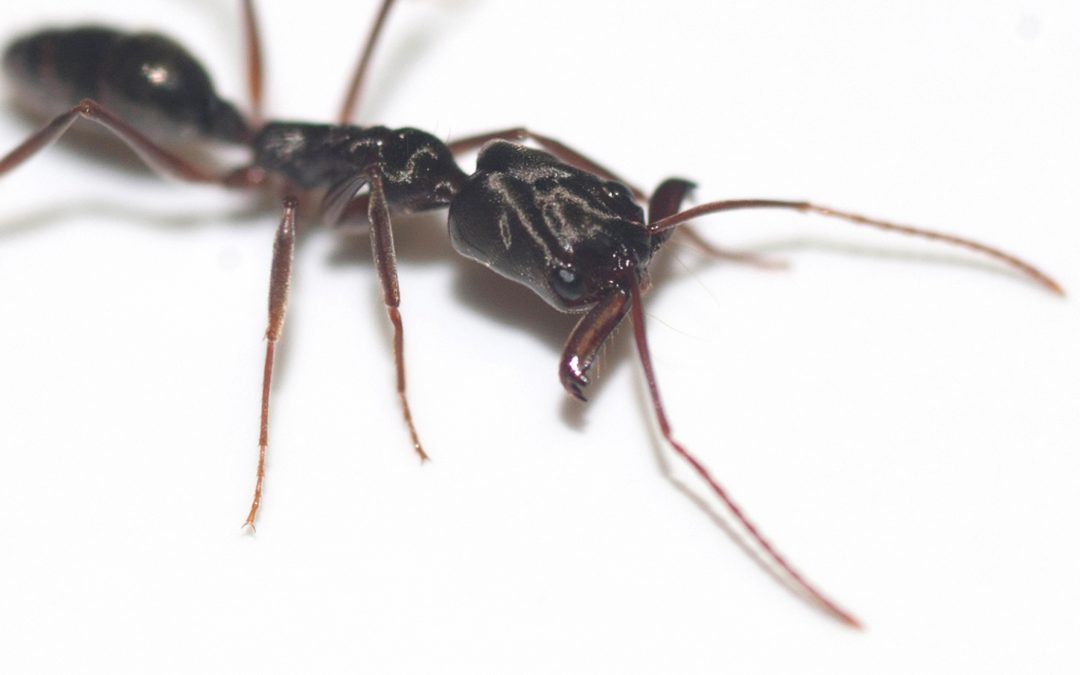
by Beth Bolles | Apr 16, 2019
One of the interesting ants that I am seeing more commonly in landscape settings is the Trap jaw ant (Odontomachus sp.). This ant is so named because of it’s large mandibles (mouthparts) that spring shut capturing prey. These mouthparts can also be used as a defensive mechanism allowing the ant to spring away from something it encounters.

Trapjaw ants. Photo by MSU Ag Communications/Kat Lawrence
A nesting area is very recognizable after you have seen one because it looks like a collection of soil and small wood debris piled at the base of plants or old stumps. I have encountered nesting areas around living shrubs in many mulched areas of the landscape and under pots sitting on old tree stumps.
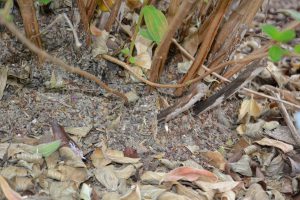
Nesting debris from the Trapjaw ants at the base of a Princess flower. Photo by Beth Bolles, UF / IFAS Extension Escambia County.
My first experience with the trap jaw ant was not very pleasant. I was working in a mulched area pulling a few weeds without gloves. I unknowingly disturbed the nest and received a pain sting similar to a paper wasp sting. The discomfort was short-lived and I personally did not have inflammation or inching a few minutes later. Of course, I identified the ant and have since become very familiar with recognizing nesting spots.
Although trap jaw ants are not native to our area, they do not rank in the same category as fire ants which are both economically and medically problematic. Since trap jaw ants are currently found in more natural areas of the landscape, homeowners should just be aware of their presence. Consider a pair of gloves or garden tools when rooting around in mulch. When a nesting area is disturbed, the large ants (about .5 inches) will be easy to observe as one of the more interesting ants we may encounter.

by Sheila Dunning | Apr 9, 2019
 Call 811 before you dig. No one wants a weekend project to be the cause of Internet, phone and cable outages. Worse yet, what if someone gets hurt from contact with natural gas or electrical lines? That’s why it is so important to have buried utilities in the yard located and marked before digging. Sunshine 811 coordinates each individual company to clearly mark where the service lines are located. Homeowners are required by law to contact 811 three days before any soil removal is done. The service is free.
Call 811 before you dig. No one wants a weekend project to be the cause of Internet, phone and cable outages. Worse yet, what if someone gets hurt from contact with natural gas or electrical lines? That’s why it is so important to have buried utilities in the yard located and marked before digging. Sunshine 811 coordinates each individual company to clearly mark where the service lines are located. Homeowners are required by law to contact 811 three days before any soil removal is done. The service is free.
Have information prepared before making the request. Describe the work to be performed (e.g. fence install, landscaping, irrigation install), including the type of equipment that will be used. Specify the exact location on the property and how long the work will continue. Finally, provide all the contact information (e.g. name, phone number, e-mail), should there be any additional questions.
Call 811 or request a single address ticket online. Receive a ticket number and wait two full business days, not counting weekends or holidays. Then contact 811 again. Make sure that all the utilities have responded in the Positive Response System (PRS). Sometimes that may mean that the company doesn’t have anything to make in the area.
If there are utility lines running through the yard, they will be marked with specifically colored paints or flags. Red is used for electrical lines, orange indicates communication lines, yellow means gas, blue is used for potable water, purple is reclaimed water, and green indicates sewer lines. White lines may be used to outline digging areas and pink are temporary survey marks. This is the APWA Uniform Color Code.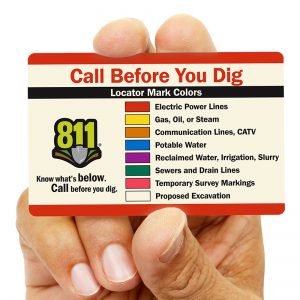
Every effort is made to locate the lines as accurately as possible. But, the safest thing to do is hand dig to expose the utility line before using any mechanized equipment. Lines can vary up to 24” from the marked line and depths can be less than 5”. Remember there may be access lines running through the property even if that service isn’t utilized at that address.
Keep safe this spring. Call 811 before digging.
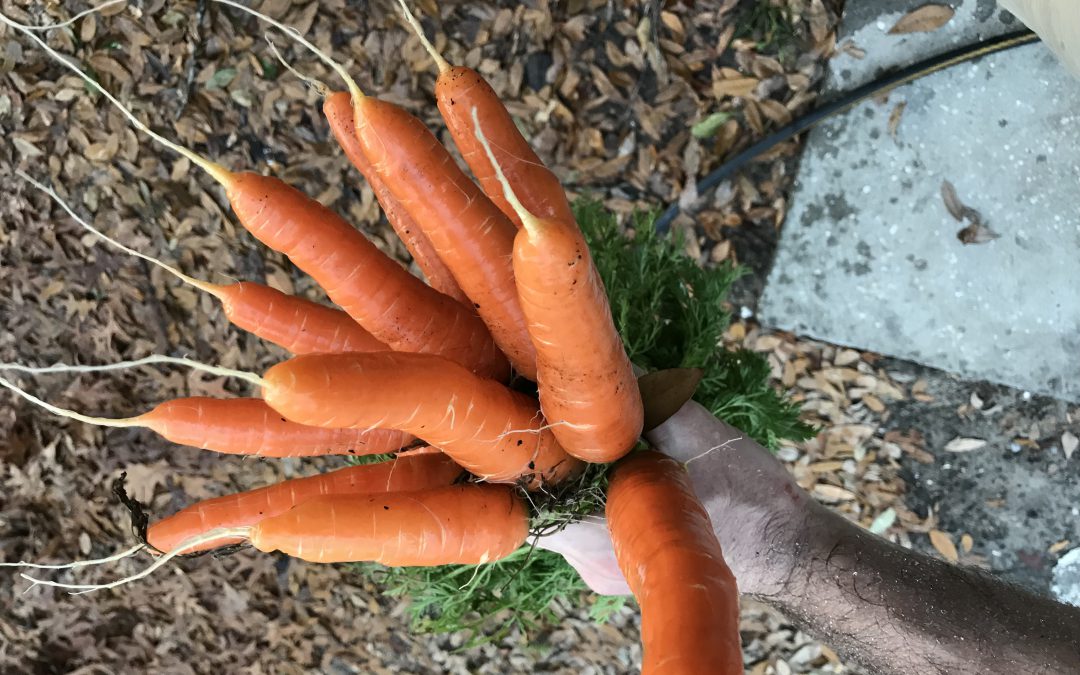
by Daniel J. Leonard | Apr 8, 2019

Carrots growing in a large container.
After tending a home vegetable garden for any length of time in the Panhandle, you begin to learn some things. Tomatoes are awfully hard to grow. Raised beds drastically lower the difficulty of gardening in general. You should never plant mint in a permanent veggie garden. Swiss Chard has to be started early because it grows as molasses creeps. Of all of these anecdotal maxims I’ve discovered, the one with the most flavor return on my gardening investment is that carrots should always be a part of your cool season garden. A fresh carrot out of the garden is hard to beat. The difference between a grocery store carrot and one fresh out of your own garden is astonishing and will change your culinary life. Though carrot season in Florida is just ending (my final batch was harvested yesterday), it’s the perfect time to learn about growing carrots here and plan to get some in the ground this fall!
There are a number of reasons to grow and eat carrots. They’re obviously very healthy, though I dispute the whole eat carrots and you’ll have great eyesight thing – apparently I acquired the taste for them too late to help. They go well in more dishes than they don’t. However, the real two reasons you should supplement your grocery store carrot purchases with home grown harvests are that they’re so easy to grow and that there are so many more options than the standard long, thin orange varieties adorning the produce aisle shelves.
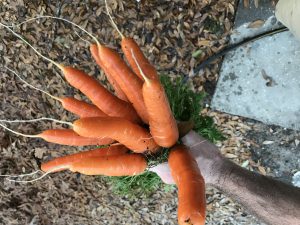
‘Bolero’ Carrots
Though carrots are remarkable easy to grow, they do ask a couple of things of gardeners. They are a cool season vegetable and are generally planted from seed beginning in late August through early September in the Panhandle, though successive plantings can continue through at least February if you want to extend your harvest. Also, like many other root vegetables, carrots don’t transplant well so direct seeding in the garden is a must. But before you even consider seeding, care must be taken to make sure the soil bed you’ll be seeding in has been properly prepared. One of the few ways to fail growing carrots is to not start with a loose soil free from any potential obstructions. If the development of the carrot root is disturbed by anything during the germination and growing process (this includes manure aggregates or other clumpy soil, sticks, rocks or even a hard layer of soil hiding under your loose compost), the end product will be deformed. To prevent this, thoroughly till your raised bed soil to at least 12” and break up any larger soil particles that are left with your hands. If you don’t get your soil bed perfect though, fear not, deformed carrots are definitely edible, they just won’t look like they’re supposed to and are more difficult to clean and process!
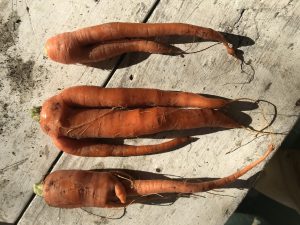
Deformed carrots due to clumpy compost!
Once you’re ready to plant, I’ve found it easier on poor eyes and fumbling fingers like mine to sprinkle the tiny carrot seeds in shallowly furrowed rows 10”-12” apart and thin the seedlings later, rather than trying to individually space seeds the recommended 1”-3” apart. Finally, these colorful little veggies love water and require good fertility. To ensure good expansion of the edible root, maintain consistent moisture and fertilize at planting with a good slow release fertilizer. Additional fertilizer applications may be required later in the growing season as most carrots take around ten weeks to gain maturity.
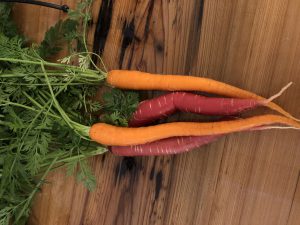
‘Sugarsnax’ (orange) and ‘Malbec’ (red) carrots
In this age of online catalogs, farmer’s markets, and demanding consumers who crave interesting food, the selection of carrot varieties available for gardeners to grow has never been better. Among the hundreds of individual cultivar options are several broad types of carrots you’ll need to choose from. You’re probably familiar with the Imperator types. These are the extra-long, durable carrots most often find in stores. If you have a deep raised bed or other large container, Imperator varieties can be extremely rewarding! I grew the Imperator-type ‘Sugarsnax’ this year and highly recommend it for ease of growing, size and flavor. Next up are the Nantes types. These carrots are medium length and cylindrically shaped. Sometimes called “storage” carrots, these types tend to store well for long periods of time after harvest and retain their flavor well. I’ve tried a few over the last several years and can recommend ‘Bolero’ and ‘Napoli’ with confidence. There is even a carrot type for those of you with shallow raised beds (8” or less) that can’t accommodate the previously listed types! Chantenay type carrots are excellent performers in these situations as they are generally a bit shorter and possess a conical shape with roots wider at the top and tapering to the tip, making a deep soil bed a bit less critical. Finally, there are even some excellent cultivars of carrots in colors other than orange! That’s right, you can grow white, purple, yellow, and even red carrots! I’ve done very well with ‘Purple Haze’ (purple with orange interior), ‘White Satin’ (creamy white color), and ‘Malbec’ (deep, rich red) and highly recommend all three. Keep in mind that the red and purple carrots tend to lose their color when cooked, so the greatest effect is seen when eaten fresh. All of these cultivars can be found at nearly any of the numerous online and catalog seed retainers such as Johnny’s Selected Seeds, Baker Creek Heirloom Seeds, Burpee, and others.
As you can see, carrots are an easy to grow, extremely rewarding vegetable for the home gardener; give some a try in your raised beds next fall! And as always, if you have any questions about growing carrots or any other gardening related question, contact your local UF/IFAS Extension office!

by Mary Salinas | Feb 26, 2019
You never know what you’ll find when you start looking closely in your garden. I was puzzled as to why there were three dead leaves hanging together on my sweetbay tree when all the other leaves looked so nice and healthy. On further investigation, I found a cocoon was made by binding the leaves together and it was firmly attached to the branch with silk.

The hanging dead leaves are a perfect hiding place for the cocoon of the sweetbay silkmoth. Photo credit: Mary Salinas.
This is the cocoon of the Sweetbay silkmoth, Callosamia securifera. Adult females lay their eggs on the native sweetbay tree, Magnolia virginiana, as the caterpillars only feed on sweetbay leaves. The trees tolerate having a few leaves eaten so there is no need to pick off the caterpillars if you find them. Local birds may do that for you as they rely on an abundance of caterpillars to feed their baby birds.
See photos of this beautiful moth with more details on its life cycle.
And then explore Gardening with Wildlife on UF/IFAS Gardening Solutions.



















